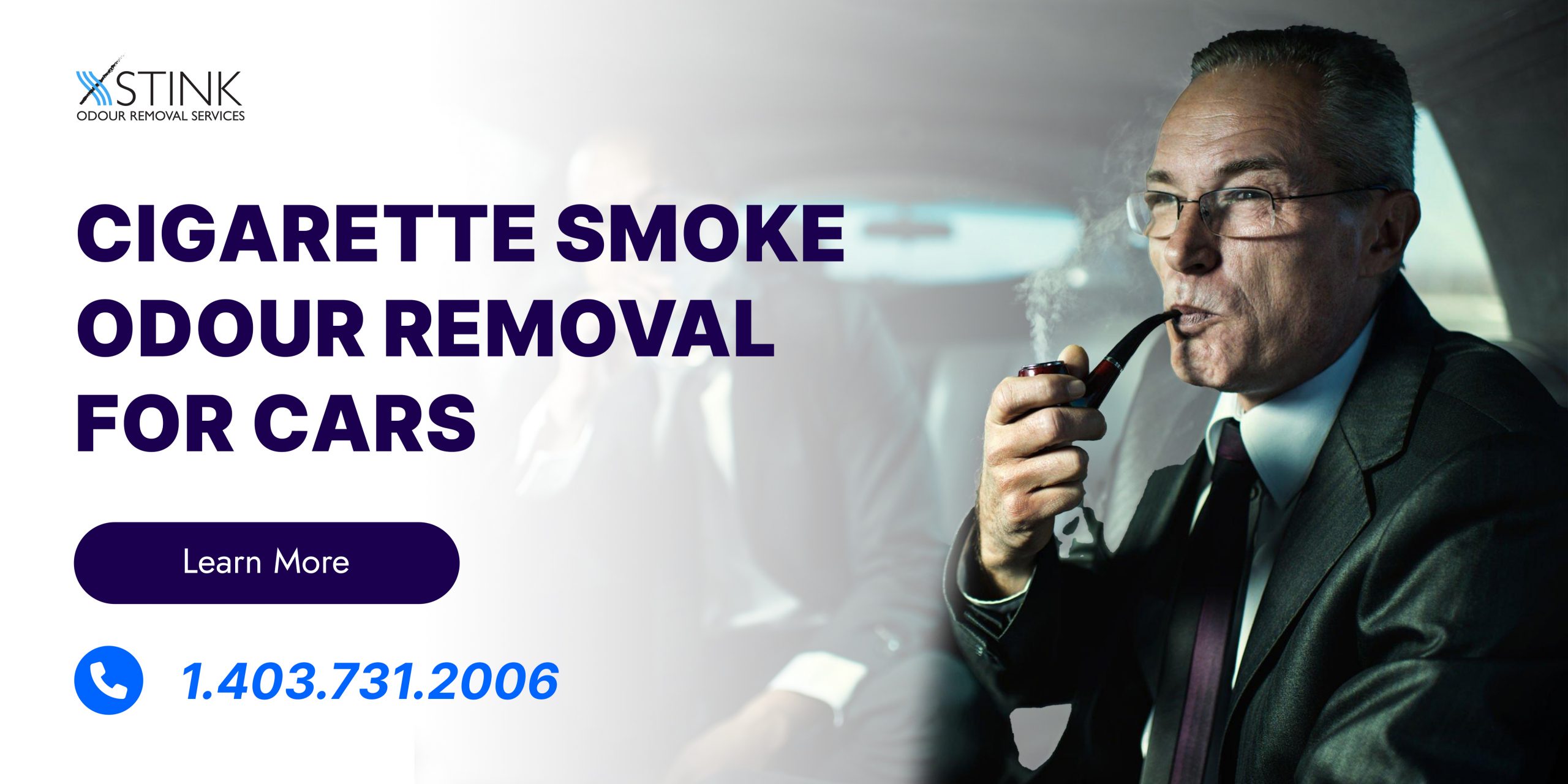UNCOVERED: Cigarette Smoke Odour Removal for Cars
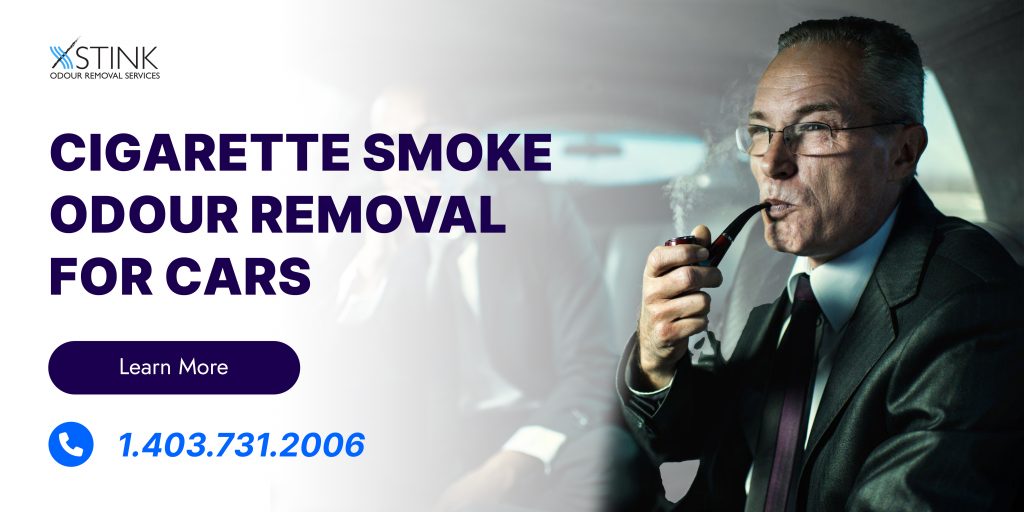
Cigarette smoke odour removal for cars is a common concern among vehicle owners in Calgary, Alberta, Canada, and it’s a topic that demands attention for those seeking a fresh and pleasant driving experience.
In this blog post, we’ll explore the intricacies of cigarette smoke odour removal for cars, providing you with valuable insights and practical tips to banish the lingering scent of tobacco from your vehicle’s interior.
Whether you’re a non-smoker dealing with a pre-owned car that carries the remnants of its previous owner’s habits or a smoker aiming to maintain a smoke-free environment, our comprehensive guide will equip you with the knowledge and techniques needed to revitalise your car and enjoy a clean and odour-free ride.
Importance of Cigarette Smoke Odour Removal
Cigarette smoke odour removal is critical to maintaining a clean and healthy car interior.
The importance of removing cigarette smoke odours cannot be overstated, as the lingering smell not only affects the comfort and aesthetics of the vehicle but also poses health risks to passengers.
The smell of cigarette smoke can be offensive and repelling to many individuals, making it vital for car owners to address this issue promptly.
Additionally, a car with a persistent smoke odour may lose resale value and appeal to potential buyers, making odour removal a practical investment.
Effects of Cigarette Smoke on Car Interiors
Cigarette smoke can have a detrimental impact on car interiors, both in terms of aesthetics and functionality.
The tar and nicotine present in cigarette smoke can adhere to various surfaces within the car, such as upholstery, carpets, and dashboard materials.
Over time, this accumulation can cause discolouration, staining, and the formation of unsightly residues.
Moreover, the smoke particles can penetrate deep into the upholstery and fabric, making it challenging to eliminate the odour completely.
In addition to aesthetic concerns, the smoke can also contribute to poor air quality within the vehicle, potentially causing health issues for occupants.
Therefore, understanding the effects of cigarette smoke on car interiors underscores the need for thorough odour removal efforts.
Removing cigarette smoke odours from car interiors is crucial for maintaining aesthetics and comfort and ensuring passengers’ health and safety. Cigarette smoke can have a detrimental impact on car interiors, causing discolouration, staining, and health concerns, highlighting the necessity of effective odour removal.
Understanding Cigarette Smoke Odour
Composition of Cigarette Smoke
Cigarette smoke is a complex mixture of thousands of chemicals, many of which are harmful to human health.
It primarily consists of two main phases: the particulate phase and the gaseous phase.
The particulate phase includes tiny solid and liquid particles suspended in the air, such as tar, nicotine, and various carcinogens.
These particles can settle on surfaces in a car and contribute to odour and staining.
The gaseous phase comprises volatile organic compounds (VOCs), including formaldehyde and benzene, which are responsible for the characteristic odour of cigarette smoke.
These VOCs can easily penetrate porous materials in the car, making odour removal challenging.
Understanding the composition of cigarette smoke is crucial for effective odour removal strategies as it provides insight into the types of contaminants that need to be addressed.
How Smoke Odours Permeate Car Interiors
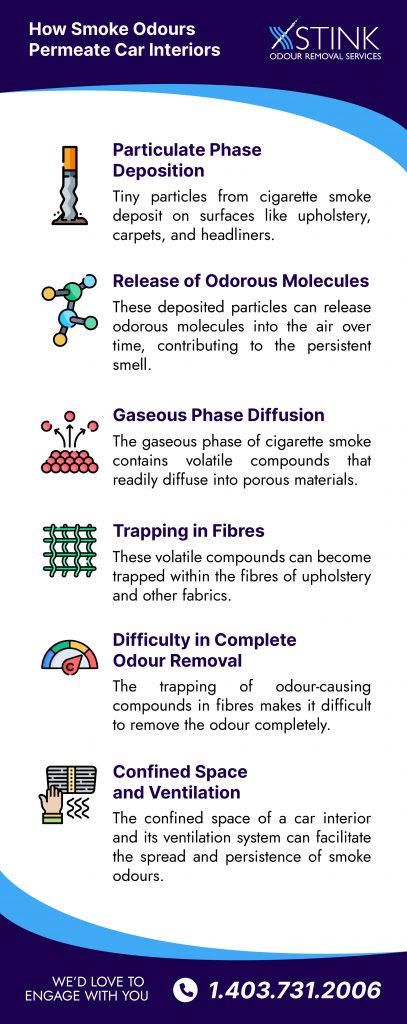
Smoke odours in cars permeate interior spaces through a combination of factors.
First, the particulate phase of cigarette smoke deposits tiny particles on surfaces such as upholstery, carpets, and headliners. These particles can release odorous molecules into the air over time, contributing to the persistent smell. Additionally, the gaseous phase of cigarette smoke contains volatile compounds that readily diffuse into porous materials. These compounds can become trapped within the fibres of upholstery and other fabrics, making it difficult to remove the odour completely. The confined space of a car interior and its ventilation system can further facilitate the spread and persistence of smoke odours. Understanding how these odours permeate car interiors helps in devising effective strategies to eliminate them.
Health Hazards Associated with Smoke Odour
Cigarette smoke odour in cars poses significant health hazards to occupants.
Even after the visible smoke has dissipated, harmful chemicals from the smoke can linger in the air and on surfaces.
Breathing in these residual chemicals can irritate the respiratory system and may trigger or exacerbate allergies and asthma.
Moreover, exposure to the carcinogens present in cigarette smoke, even in trace amounts, can increase the risk of long-term health issues, including cancer.
It is essential to recognise that smoke odour is not merely a nuisance but a potential health threat, especially for those with sensitivities or pre-existing respiratory conditions.
This underscores the importance of thorough smoke odour removal in cars to ensure a safe and healthy environment for both drivers and passengers.
Understanding cigarette smoke odour is crucial, as it involves recognizing the harmful composition of cigarette smoke, the factors contributing to odour permeation in car interiors, and the significant health hazards it poses to occupants, emphasizing the need for effective odour removal.
Preparing for Odour Removal
Gathering Necessary Supplies
Before embarking on the process of cigarette smoke odour removal from a car, it is essential to gather all the necessary supplies.
These supplies typically include cleaning agents such as upholstery cleaners, carpet shampoos, and all-purpose cleaners.
Additionally, you may need cleaning tools like brushes, microfiber cloths, and a vacuum cleaner with attachments suitable for car interiors.
For more advanced odour removal, air purifiers and deodorisers may be required.
Having these supplies readily available ensures that the odour removal process proceeds smoothly and efficiently, reducing the risk of having to pause and search for items in the middle of cleaning.
Ventilation and Safety Precautions
Ventilation and safety precautions are crucial when preparing for cigarette smoke odour removal.
Given that you’ll be dealing with cleaning agents and potentially airborne particles, proper ventilation is essential to dissipate odours and maintain good air quality.
It’s advisable to perform odour removal in a well-ventilated area or with the car windows open.
Furthermore, wearing appropriate personal protective equipment, such as gloves and a mask, can protect against exposure to cleaning chemicals and allergenic particles.
Adequate ventilation and safety precautions help ensure the safety of the individuals involved in the odour removal process.
Removing Personal Belongings
Before commencing the odour removal process, removing all personal belongings from the car is important. This includes items like clothing, electronics, and any valuables.
Removing personal belongings ensures that they are not damaged or affected by the cleaning process and allows for thorough cleaning of all surfaces in the car.
It’s also a practical step to prevent any contamination of personal items with residual odours or cleaning agents.
Cleaning out the car of personal belongings streamlines the cleaning process and prevents any potential mishaps during odour removal.
Proper preparation for cigarette smoke odour removal includes gathering necessary cleaning supplies, ensuring adequate ventilation, adhering to safety precautions, and removing personal belongings from the car to streamline the cleaning process and prevent any potential mishaps during odour removal.
Cleaning and Deodorising Car Interior
Vacuuming and Dusting
The initial step in cleaning and deodorising a car’s interior is vacuuming and dusting.
Using a car vacuum cleaner with appropriate attachments, begin by vacuuming all surfaces, including the seats, carpets, mats, and the interior roof (headliner).
This process helps remove loose dirt, dust, and debris that may trap odours and affect air quality.
Pay special attention to crevices, seams, and hard-to-reach areas where dirt and debris tend to accumulate.
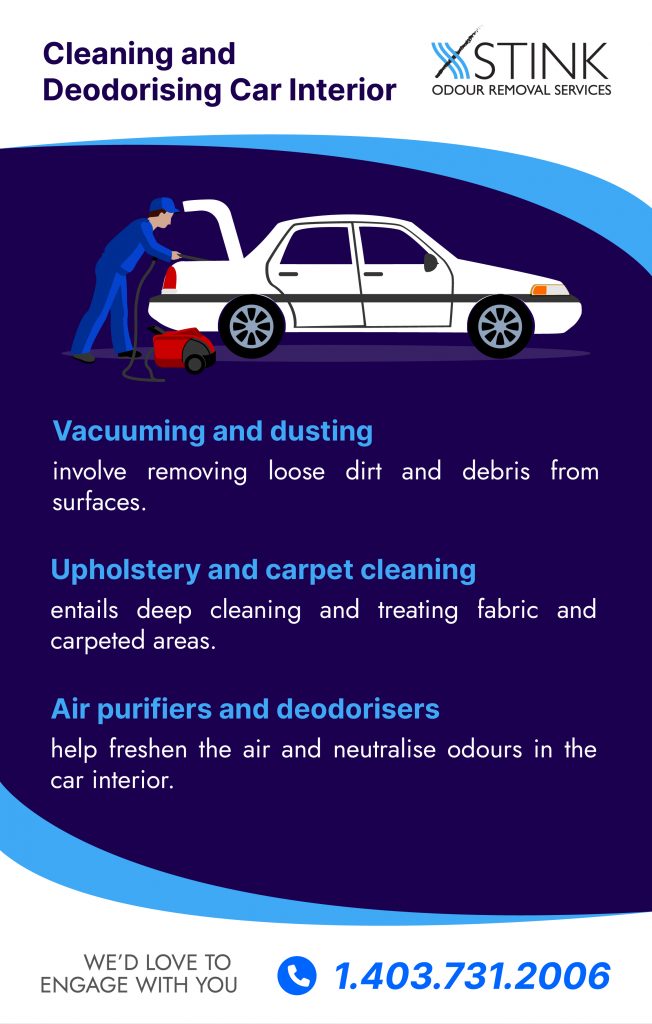
Dusting with a microfiber cloth can also be used for surfaces that aren’t suitable for vacuuming, such as the dashboard and console.
Proper vacuuming and dusting create a clean starting point for the subsequent cleaning steps.
Upholstery and Carpet Cleaning
Choosing the Right Cleaning Products
Selecting the right cleaning products is crucial when cleaning car upholstery and carpets.
Different materials and stains require specific cleaning agents.
For fabric upholstery and carpets, mild upholstery cleaners or carpet shampoos are typically suitable.
Leather upholstery, on the other hand, requires leather-specific cleaners.
Always check manufacturer recommendations and test any new cleaning products on a small, inconspicuous area to ensure they won’t damage or discolour the material.
It’s also essential to choose products with deodorising properties to help eliminate smoke odours effectively.
Scrubbing and Spot Cleaning
After choosing the appropriate cleaning products, proceed to scrub and spot clean the car’s upholstery and carpets.
Follow the product instructions carefully, typically involving the application of the cleaner, gentle scrubbing with a soft brush or cloth, and then wiping or rinsing away the residue.
Focus on areas with visible stains or odour concentration, such as seat cushions and floor mats.
Thoroughly scrubbing and spot cleaning not only removes dirt and stains but also helps in reducing the presence of odorous particles trapped within the materials.
Ensure that all cleaning agents are completely removed to prevent any potential residue from causing further odour issues. This step is critical for achieving a clean and odour-free interior.
Air Purifiers and Deodorisers
Types of Car Air Purifiers
Car air purifiers come in various types, and understanding their differences can help in effectively deodorising the car interior.
The primary types of car air purifiers include mechanical filters, activated carbon filters, ozone generators, and electronic air purifiers.
Mechanical filters, such as HEPA filters, can capture and remove particulate matter from the air, including smoke particles.
Activated carbon filters are effective at adsorbing odours and volatile organic compounds (VOCs).
Ozone generators release ozone gas, which can help break down odorous molecules, but their use should be approached with caution due to potential health concerns.
Electronic air purifiers use ionization or other technologies to remove particles from the air.
When choosing a car air purifier, consider your specific needs, the size of your vehicle, and any potential health concerns associated with certain types of purifiers.
Use of Deodorising Products
In addition to air purifiers, using deodorising products can be a valuable part of the odour removal process.
These products are designed to neutralise or mask odours within the car interior.
Odour neutralisers work by chemically binding with odorous molecules to render them non-volatile and less detectable to the nose.
Air fresheners and deodorising sprays typically mask odours with pleasant scents.
When using deodorising products, choosing ones that are safe for use in enclosed spaces and specifically designed for vehicles is essential.
Overuse of strong scents can be overpowering and may not effectively address the underlying odour issue.
A balanced approach combining both air purifiers and deodorising products can help achieve a fresh and odour-free car interior.
Cleaning and deodorising a car’s interior involves a systematic process, including vacuuming and dusting to remove loose dirt and debris, selecting appropriate cleaning products for different materials, scrubbing, and spot cleaning to target stains and odours, and using car air purifiers and deodorisers to enhance odour elimination, contributing to a clean and refreshed car interior.
Targeting Specific Odour Sources
Cleaning Ashtrays and Cigarette Receptacles
Cleaning ashtrays and cigarette receptacles is crucial in addressing cigarette smoke odours in cars.
These areas are direct sources of odour contamination, as they accumulate ash, burnt tobacco residues, and the smell of stale smoke.
To effectively clean them, empty and dispose of any remaining cigarette butts and ash.
Then, wash the ashtray and receptacle thoroughly with hot soapy water, removing all visible residue.
Rinse and dry these components before returning them to the car.
Regular cleaning of ashtrays and receptacles helps prevent odour buildup and is essential for maintaining a smoke-free car interior.
Cleaning and Treating Fabric and Upholstery
The fabric and upholstery in a car’s interior readily absorb cigarette smoke odours due to their porous nature. To address these areas, cleaning and treating them properly is essential.
Begin by vacuuming these surfaces to remove loose dirt and debris. Next, apply an appropriate fabric or upholstery cleaner as mentioned above.
Allow the cleaner to sit for a few minutes to penetrate and break down odour-causing compounds.
Then, gently scrub the fabric with a soft brush or cloth, paying extra attention to areas with visible stains or concentrated odours.
After scrubbing, rinse or wipe away the cleaning solution and allow the fabric to dry thoroughly.
Treating fabric and upholstery with odour-neutralising products or upholstery-specific deodorisers can provide additional protection against lingering smoke odours.
Cleaning Hard Surfaces
Hard surfaces in the car interior, such as the dashboard, console, steering wheel, and door panels, can also retain cigarette smoke odours.
To clean these areas effectively, use a soft or microfiber cloth to wipe away surface dust and grime.
For more stubborn residue or odours, use a mild all-purpose cleaner or a cleaner specifically designed for automotive interiors.
Apply the cleaner to a cloth, not directly to the surfaces, to prevent overspray or drips.
Gently scrub the surfaces, paying attention to textured areas and crevices where odour-causing particles may accumulate.
Ensure that all residues are thoroughly wiped away, and surfaces are left clean and dry.
This step contributes to an overall fresh and odour-free car interior, as smoke odours can be trapped in these surfaces if not properly addressed.
Targeting specific odour sources within a car, such as cleaning ashtrays and cigarette receptacles, addressing fabric and upholstery with proper cleaning and treatment, and cleaning hard surfaces, is essential for effectively eliminating cigarette smoke odours and maintaining a smoke-free car interior.
Professional Odour Removal Services
Benefits of Professional Services
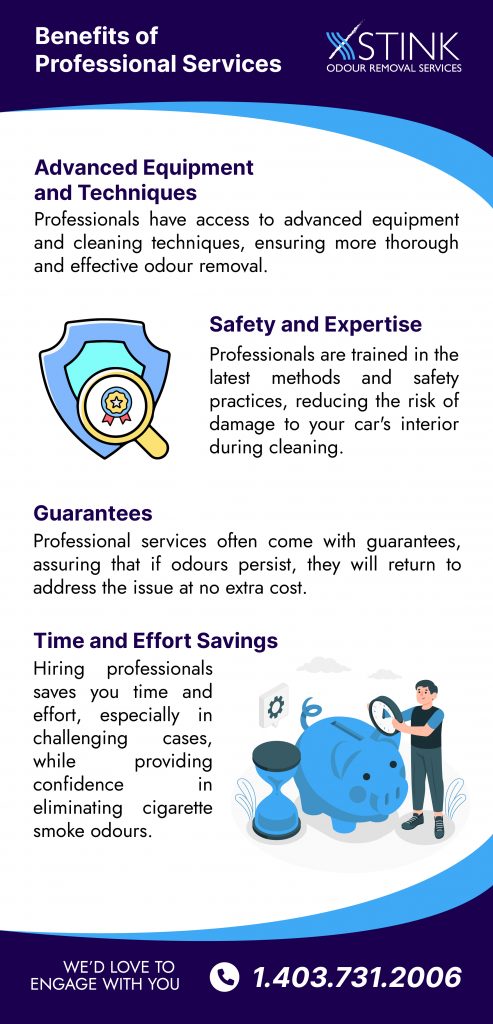
Opting for professional odour removal services for your car offers several significant advantages.
Firstly, professionals have access to advanced equipment and cleaning techniques that may not be readily available to the average car owner. This can result in more thorough and effective odour removal. Professionals are also trained in the latest methods and safety practices, reducing the risk of damage to your car’s interior during cleaning. Moreover, professional services often come with guarantees, ensuring that if odours persist, they will return to address the issue at no extra cost.
Hiring professionals can save you time and effort while providing confidence in the elimination of cigarette smoke odours, making it a wise choice for challenging cases.
How to Choose a Car Odour Removal Service
Selecting the right car odour removal service is crucial for a successful outcome.
Start by researching local providers and reading reviews from previous customers to gauge their reputation and effectiveness.
Verify that the service provider specialises in odour removal, as this ensures they have the expertise and equipment required for the job.
It’s also essential to inquire about their specific methods and products, ensure they are safe and effective.
Additionally, ask about their experience with cigarette smoke odour removal, as this issue is particularly stubborn and pervasive.
Finally, request quotes from multiple providers and compare their prices, services, and warranties to make an informed decision.
Cost Considerations
The cost of professional odour removal services for your car can vary widely depending on several factors.
The size of your vehicle, the severity of the odour, the chosen service provider, and your location all influence the overall cost.
Generally, larger vehicles with more extensive odour contamination will require more time and resources, resulting in higher costs.
Service providers may offer different pricing models, such as flat fees or hourly rates, so clarifying this upfront is important.
While professional services may seem more expensive initially, they often provide a cost-effective solution when compared to the time and effort required for DIY methods that may not guarantee success.
Consider the value of a fresh and odour-free car interior and weigh it against the cost when deciding whether professional services are worth the investment.
Professional odour removal services offer advanced techniques, expertise, and guarantees for tackling stubborn cigarette smoke odours. When choosing a service, research, specialize, inquire about methods, and compare quotes to make a cost-effective decision that ensures a fresh and odour-free car interior.
Preventing Future Smoke Odours
Establishing a Smoke-Free Policy
One effective way to prevent future smoke odours in your car is to establish a strict smoke-free policy for all occupants.
Communicate this policy clearly to friends, family members, and passengers who may ride in your vehicle.
Ensure that everyone understands and respects your decision not to allow smoking inside the car.
By setting these boundaries, you reduce the likelihood of smoke odours permeating the interior in the first place.
Encourage smokers to smoke outside the vehicle and provide them with a designated area for disposal of cigarette butts.
Consistently enforcing a smoke-free policy is key to maintaining a fresh and odour-free car interior.
Using Car Air Fresheners
Car air fresheners can be a helpful tool in keeping your car smelling pleasant and preventing smoke odours from returning.
Various car air fresheners are available, including hanging air fresheners, vent clips, and plug-in diffusers.
Choose a fragrance that you find appealing and consider options that have odour-neutralising properties to effectively combat smoke odours.
It’s important not to rely solely on air fresheners to cover up smoke odours but rather use them as a complementary measure to maintain a pleasant scent in your car.
Regularly replace or refill air fresheners to ensure their effectiveness over time.
Regular Maintenance and Cleaning
Regular maintenance and cleaning are essential for preventing the buildup of smoke odours in your car.
Make it a habit to clean the interior of your vehicle on a consistent schedule.
Vacuuming, dusting, and wiping down surfaces help remove dirt, dust, and potential odour sources.
Promptly address spills and stains to prevent them from becoming permanent odour sources.
Additionally, consider using fabric protectants on upholstery and carpets to create a barrier against odour penetration.
Regular maintenance also includes cleaning ashtrays and receptacles to prevent them from becoming sources of odours.
Maintaining a clean and well-ventilated car interior can significantly reduce the risk of smoke odours returning and enjoy a fresh driving experience.
FAQs in Relation to Cigarette Smoke Odour Removal for Cars
How do I remove cigarette smoke odour from my car?
To remove cigarette smoke odour from your car, start by thoroughly cleaning all interior surfaces, including upholstery, carpets, and hard surfaces, using appropriate cleaning products.
Consider using car air purifiers and deodorisers. If the odour persists, professional odour removal services may be necessary for more stubborn cases.
Can I use household cleaning products to remove smoke odour from my car?
Yes, you can use some household cleaning products, but choosing those suitable for car interiors is essential.
Be cautious about using products with strong scents, as they may mask the odour rather than eliminating it. Specific automotive upholstery and carpet cleaners are often more effective.
How long does it take to completely remove cigarette smoke odour from a car?
The time required to eliminate cigarette smoke odour from a car can vary depending on the severity of the odour and the methods used.
In mild cases, it may take a few hours to a day. More stubborn odours may take several days of cleaning and treatment.
Are professional odour removal services expensive?
The cost of professional odour removal services can vary based on factors like the size of your vehicle and the extent of the odour.
While professional services may seem expensive, they often provide a cost-effective solution compared to the time and effort required for DIY methods that may not guarantee success.
How can I prevent cigarette smoke odours from returning to my car?
Preventing smoke odours from returning involves establishing a smoke-free policy for your car, using car air fresheners with odour-neutralising properties, and maintaining regular cleaning and maintenance routines.
These measures help maintain a fresh and odour-free car interior.
Effective Cigarette Smoke Odour Removal for Cars Is Essential for a Refreshed and Odour-Free Driving Experience
In conclusion, successfully tackling cigarette smoke odour removal for cars requires time, effort, and the right strategies.
We’ve covered a range of effective methods to help you enjoy a fresh and pleasant driving experience.
However, for those facing persistent or particularly challenging odours, remember that professional help is readily available.
Don’t hesitate to reach out to XStink Odour Removal Services, as they possess the expertise and advanced tools needed to completely eliminate stubborn smoke odours from your vehicle.
By taking the initiative and seeking professional assistance, you can ensure that your car remains a clean and inviting space, free from the lingering scent of tobacco.
So, if the odour persists, take that step and enlist the expertise of professionals in cigarette smoke odour removal for cars. Your vehicle—and your senses—will thank you for it.

